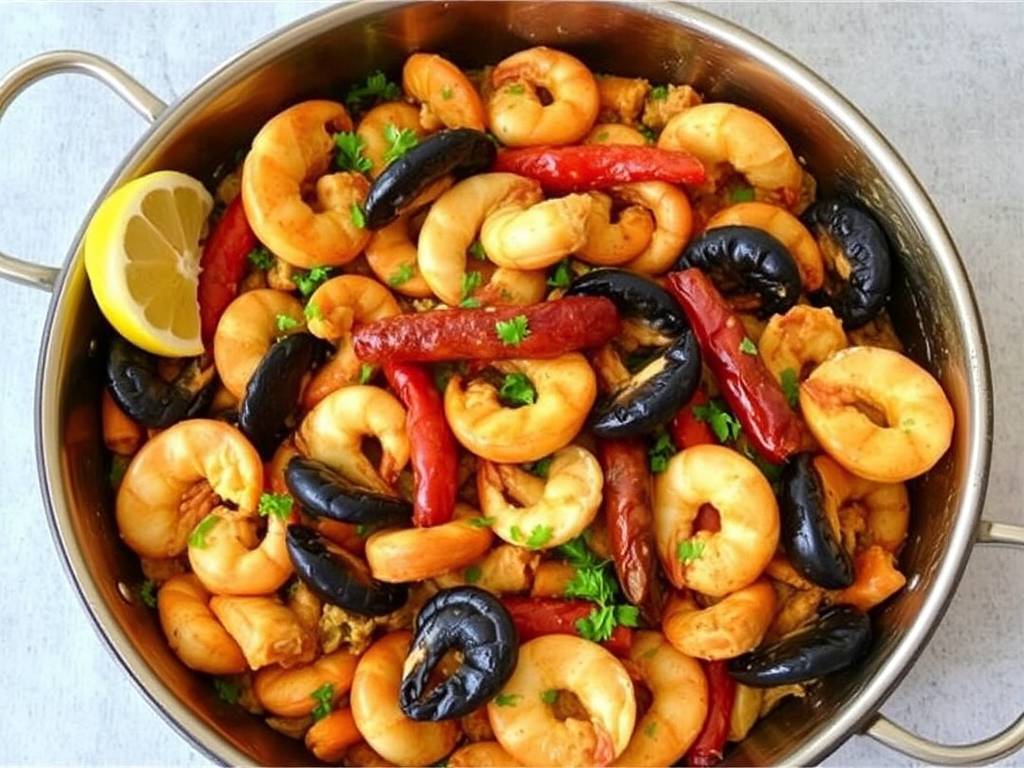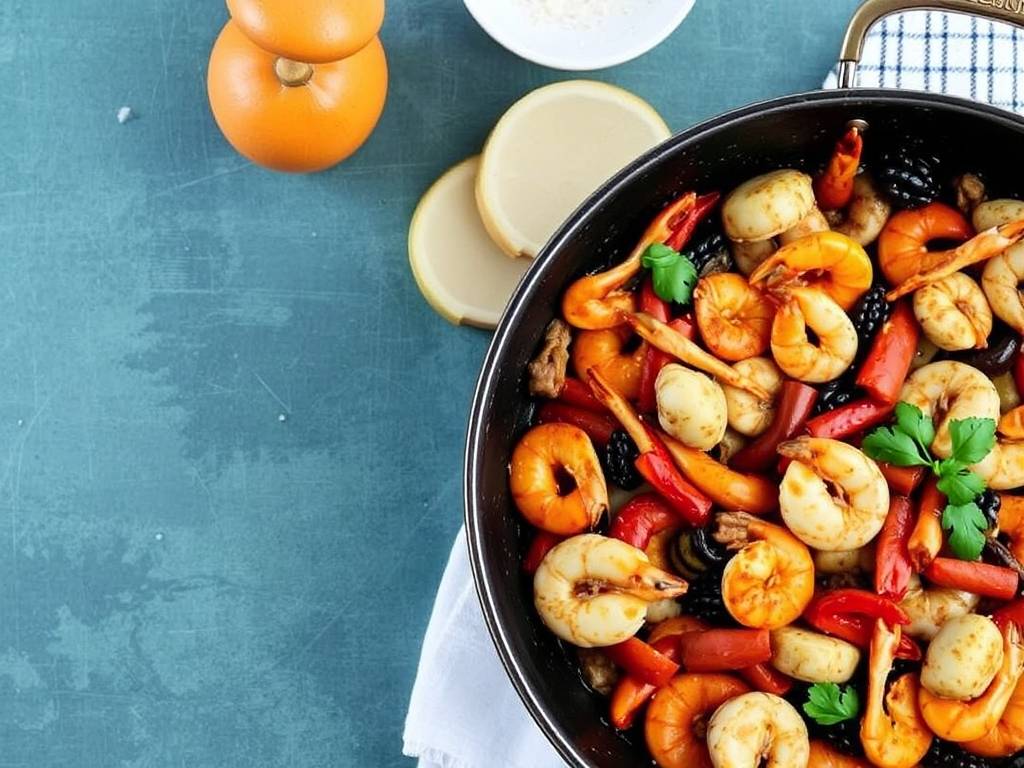The Ultimate Guide to Crafting Authentic Seafood Paella with Chorizo at Home
There's something magical about a steaming pan of seafood paella with chorizo arriving at the table. The vibrant saffron hue, the medley of plump seafood, and the unmistakable aroma of smoked paprika and garlic create an experience that feels both celebratory and deeply comforting. Many home cooks are intimidated by the thought of making this Spanish classic, fearing it's too complex or requires elusive ingredients. I'm here to tell you that crafting an incredible, restaurant-worthy paella in your own kitchen is not only possible, it's an immensely rewarding adventure.
This guide is designed to be your complete companion, walking you through every single step, from selecting the perfect rice to achieving the coveted socarrat—the deliciously crispy bottom layer. We'll demystify the process, ensuring you have all the knowledge and confidence to create a show-stopping centerpiece for your next gathering.

Gathering Your Ingredients: The Foundation of Flavor
A great paella is built on the quality of its components. Let's break down what you'll need, with a focus on why each ingredient matters.
-
The Rice: This is non-negotiable. For authentic Spanish paella, you must use a short-grain rice like Bomba or Calasparra. These varieties absorb an incredible amount of liquid (up to three times their volume) without becoming mushy, which is essential for that perfect separate, tender grain texture. Using Arborio or other risotto rice will result in a creamier, stickier dish that isn't true paella.
- Long-tail keyword: "best rice for authentic seafood paella"
-
The Broth: Your paella is only as good as your broth. While a good quality fish or seafood stock works, I highly recommend making a quick shrimp broth. Simply simmer the shells from your shrimp in water with a bay leaf for 15-20 minutes. This simple step adds an incredible depth of oceanic flavor that store-bought broth can't match.
- Long-tail keyword: "homemade shrimp broth for paella recipe"
-
The Sofrito: This is the flavor base of your paella. It's a slow-cooked mixture of finely chopped onion, garlic, and tomato. Cooking it down until it's jammy and deeply caramelized is the secret to a rich, complex foundation. Don't rush this step!
-
The Proteins: Seafood & Chorizo
- Seafood: A mix of textures and flavors works best. I recommend:
- Jumbo Shrimp (prawns), with heads-on if possible for extra flavor.
- Mussels and/or Clams: They look beautiful and release briny juices into the rice.
- Squid (Calamari): Cut into rings and added early to become tender.
- Long-tail keyword: "how to choose fresh seafood for paella"
- Chorizo: Use Spanish chorizo picante (cured, spicy sausage), not Mexican chorizo, which is a fresh, crumbly sausage. The Spanish version is firm, already cooked, and packed with smoky paprika and garlic flavor. Slice it into coins so it can render its flavorful oils into the pan.
- Seafood: A mix of textures and flavors works best. I recommend:
-
The Flavor Agents:
- Saffron: The queen of spices. Yes, it's expensive, but it's essential for paella's signature color and earthy, honey-like aroma. To maximize its potency, gently toast the threads in a dry pan for 30 seconds, then crumble them into a couple tablespoons of warm broth to steep.
- Smoked Paprika (Pimentón): This provides the smoky backbone. Use pimentón de la Vera for the most authentic flavor.
- Olive Oil: A good, robust extra virgin olive oil is a must.
Essential Equipment: The Paella Pan
While you can use a wide, heavy-bottomed skillet, a traditional paellera (paella pan) is designed for the job. Its wide, shallow, flat bottom ensures the rice cooks in a thin, even layer, which is crucial for proper cooking and achieving the socarrat. A 15-inch pan is perfect for serving 4-6 people.
The Step-by-Step Process: Your Roadmap to Success
Now, let's cook! Follow these steps in order for a foolproof paella.

-
Prep is Key: Before any heat is applied, have everything ready. Chop your onion, tomato, and garlic for the sofrito. Clean your mussels and clams (discard any that are open and don't close when tapped). Devein the shrimp. Slice the chorizo and squid. Measure your rice and have your warm broth at the ready, with the saffron already steeped in it.
-
Build the Sofrito: Place your paella pan over medium heat. Add a generous glug of olive oil. Add the chopped onion and cook until softened, about 5-7 minutes. Add the garlic and cook for another minute until fragrant. Now, add the grated or finely chopped tomato. Cook this mixture, stirring occasionally, for a good 10-15 minutes until it has darkened in color, thickened significantly, and the oil starts to separate. This patience is what builds a deep, sweet base.
-
Toast the Rice and Spices: Add the sliced chorizo and let it cook for a minute to release its red, flavorful oils. Then, add the rice and stir to coat every grain in the glorious sofrito and chorizo oil. Toast the rice for about 2 minutes. Now, add the smoked paprika, giving it a quick stir to combine (be careful not to burn it). This toasting step seals the rice and allows it to better absorb the broth.
-
The Irrevocable Pour: This is the point of no return. Pour in all of your warm broth and the saffron-infused liquid. Season generously with salt. Give the pan one good shake to distribute the rice evenly—do not stir again. Stirring from this point forward will release the rice's starch and make your paella gummy, like a risotto. We want separate grains.
-
Arrange the Seafood and Simmer: Let the paella cook at a steady medium boil for about 10 minutes. The liquid will reduce. Now, artfully arrange your seafood on top. Press the mussels and clams into the rice, hinge-side down, so they open upwards. Lay the shrimp and squid rings on top. From this moment on, do not disturb the rice.
-
The Final Stage and Socarrat: Continue to cook for another 8-12 minutes, rotating the pan occasionally over the burner to ensure even cooking, until the rice is al dente and most of the liquid is absorbed. To test for the socarrat, listen to the pan. You should hear a faint crackling sound. You can also lift a bit of rice from the edge with a spoon to check for a light brown crust. If you're not getting it, increase the heat to medium-high for the last 1-2 minutes, but watch it like a hawk to avoid burning.
-
The Rest: Once cooked, remove the paella from the heat. Cover it loosely with a clean kitchen towel or a large piece of foil and let it rest for 5-10 minutes. This allows the rice to steam and absorb any remaining liquid, resulting in a perfect texture.
Serving Your Masterpiece
Bring the entire pan to the table—it's the star of the show! Garnish with fresh lemon wedges and chopped fresh parsley. The traditional way to eat is straight from the pan, with everyone digging in to get a portion of rice, seafood, and that prized crispy bottom.
Troubleshooting Common Paella Problems
- My rice is mushy/undercooked: This usually means the rice-to-liquid ratio was off or the heat was too high/low. Trust the process and use the recommended rice types. If it's undercooked and dry, add a small splash of warm broth and let it cook for a few more minutes.
- I didn't get socarrat: Next time, make sure your heat is high enough at the end. The crackling sound is your guide. A well-seasoned paella pan also helps conduct heat more evenly for that perfect crust.
- My clams/mussels didn't open: Discard any that remain closed after cooking, as they were likely dead before cooking.
Making seafood paella with chorizo is a joyful, sensory journey. It’s about embracing the process, sharing good food, and creating memories around the table. So, gather your ingredients, trust your instincts, and get ready to impress yourself and your guests with a taste of Spain, right from your own kitchen. ¡Buen provecho






发表评论